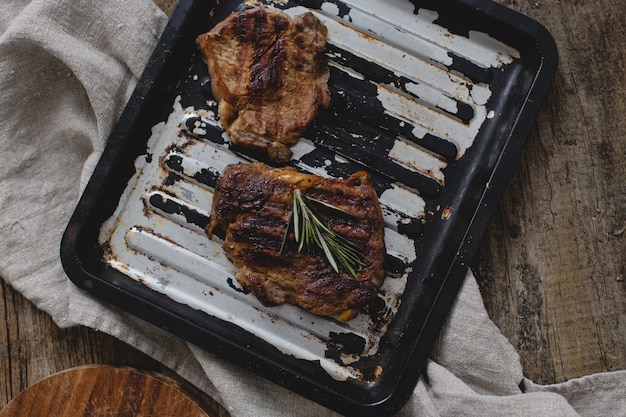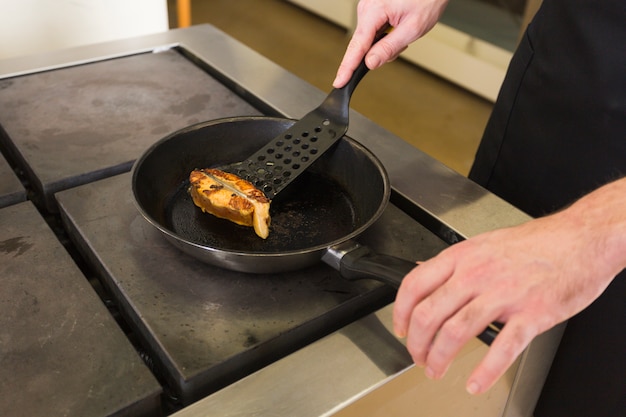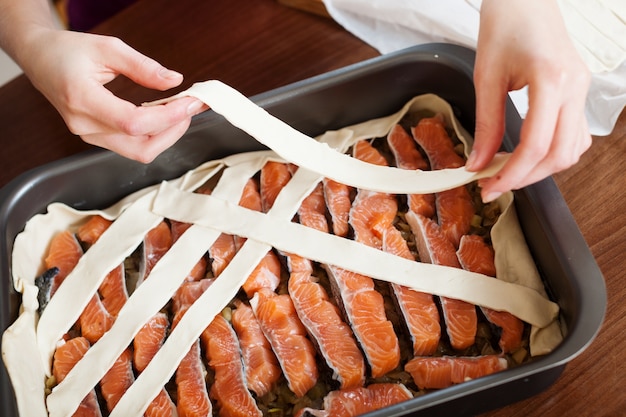Ah, the steak. A culinary icon, a symbol of indulgence, and a dish that, when done right, can be utterly transformative. And what's better than a perfectly seared, juicy steak? Not much, I'll tell you. Over the years, I've learned a thing or two about cooking steak, and I'm convinced that cast iron is the secret weapon for achieving that coveted crust and tender, flavorful interior.
Cast iron isn't just for grandma's kitchen anymore. It's a versatile and reliable tool for any home cook, and when it comes to steak, it's truly unmatched. But it's not just about the pan – it's about understanding the whole process, from choosing the right cut to mastering the science behind heat and searing. So, put on your apron, grab your sharpest knife, and let's embark on a journey to cast iron steak perfection!
Part 1: Choosing the Right Cut

1.1 Understanding Different Cuts
Before we get our hands dirty, it's crucial to understand the difference between cuts. You wouldn't try to make a delicious, melt-in-your-mouth steak out of a tough chuck roast, would you? No, that's a recipe for disappointment. For the ultimate steak experience, you need a cut that's inherently tender and marbled with fat. That fat isn't just for flavor; it's the key to keeping the steak moist and juicy.
Here's a breakdown of some popular steak cuts ideal for cast iron cooking:
- Ribeye: My personal favorite! This cut is known for its rich, beefy flavor and generous marbling, making it incredibly juicy and satisfying. Think of it as the king of steak cuts, the one you go to for a special occasion.
- new york strip: This is another excellent choice with a delicious flavor profile and a good amount of marbling. It's a bit leaner than the ribeye, but still incredibly flavorful and tender. It's a versatile steak that works well for both everyday meals and special occasions.
- filet mignon: This cut is all about tenderness. It's the most tender cut of beef, perfect for those who prefer a melt-in-your-mouth experience. However, it's also leaner than ribeye and strip, so it's important to cook it to a medium-rare or medium doneness to avoid dryness.
- T-Bone: This is a classic for a reason! It combines the best of both worlds: a tender filet mignon on one side and a flavorful New York strip on the other. It's a bit of a showstopper, especially when cooked to perfection.
- Porterhouse: Similar to the T-bone, but with a larger strip steak portion. If you're feeding a crowd, the Porterhouse is a great option.
1.2 The Quest for Quality
You can't expect a perfect steak from a subpar cut. Just like you wouldn't use cheap ingredients for a delicious cake, you need to invest in quality meat. Look for beef that has good marbling, a bright red color, and a slight firmness to the touch. Avoid cuts that are dry, have a dull appearance, or seem oddly soft. Trust me, your taste buds will thank you for splurging on a good cut.
Part 2: Prepping the Perfect Steak

2.1 Pat It Dry
Before you even think about seasoning, pat that steak dry with paper towels. This is crucial because moisture on the surface of the steak will prevent it from developing a beautiful, crispy crust. Think of it as removing the obstacles to a perfect sear.
2.2 The Art of Seasoning
Now, this is where things get fun. Seasoning a steak is an art form, and it's all about finding the perfect balance of flavors. Personally, I prefer simplicity: just salt and pepper. But feel free to experiment! Garlic powder, onion powder, paprika, a pinch of cayenne pepper – all these spices can add depth and complexity to your steak. The key is to be generous, coating the entire surface of the steak with your chosen seasonings.
And don't underestimate the power of salt! Salt not only enhances flavor but also helps to draw out moisture, leading to a more flavorful and tender steak. I like to salt my steak at least 30 minutes before cooking, giving the salt time to penetrate the meat and work its magic.
Part 3: The Cast Iron King

3.1 Choosing the Right Pan
The cast iron skillet is the star of the show, the hero of this culinary adventure. For the best results, you want a well-seasoned skillet. A well-seasoned cast iron pan has a smooth, non-stick coating that comes from years of use and careful care. If you're new to cast iron, don't worry, you can easily season a new skillet yourself! It's a simple process that involves heating the pan, oiling it, and letting it cool down. You'll be surprised how quickly your pan will develop that beautiful non-stick surface.
3.2 The Importance of Preheating
Here's where things get exciting. Preheating your cast iron skillet is crucial for achieving that perfect sear. You want the pan to be blazing hot, but not smoking hot. A good test is to drop a few drops of water onto the surface. If they sizzle and evaporate instantly, your pan is ready for action.
You can preheat the pan on the stovetop over medium-high heat, but for a more even heat distribution, I recommend preheating it in the oven at 450°F (232°C) for about 10 minutes. This will allow the pan to heat up evenly and create a consistent sear.
Part 4: mastering the sear
4.1 The Art of the Searing
Now we're getting to the heart of the matter – the searing process. This is where the cast iron skillet truly shines. The intense heat creates a beautiful, crispy crust on the surface of the steak, locking in the juices and developing a complex flavor that will leave your taste buds singing.
Carefully place the steak in the preheated skillet and let it cook undisturbed for 3-4 minutes per side. Resist the urge to move it or press down on it! Let that steak develop a nice, golden-brown crust before flipping it over.
4.2 Achieving Even Browning
For even browning, it's a good practice to rotate the steak 90 degrees halfway through each side. This prevents the steak from sticking to the pan and ensures that all sides get a beautiful, consistent sear.
Part 5: Rest, Relaxation, and Redistribution
5.1 Letting the Steak Rest
After the drama of searing, it's time for a little relaxation. Let the steak rest before slicing and serving. This allows the juices to redistribute throughout the meat, resulting in a more tender, flavorful steak.
Transfer the steak to a cutting board and loosely cover it with aluminum foil. Let it rest for 5-10 minutes, depending on the thickness of the steak.
Part 6: Doneness, Decoded
6.1 The Science of internal temperature
For the most accurate way to determine doneness, use a meat thermometer. It's a simple tool that can take the guesswork out of cooking steak. Here's a guide to internal temperatures for different levels of doneness:
| Doneness | Internal Temperature (°F) |
|---|---|
| Rare | 125-130 |
| Medium-Rare | 130-135 |
| Medium | 135-140 |
| Medium-Well | 140-145 |
| Well Done | 145-150 |
6.2 Visual Clues
If you're not using a thermometer, you can still gauge the doneness of your steak visually. Here's a guide:
- Rare: The center will be red and cool to the touch.
- Medium-Rare: The center will be pink and slightly warm to the touch.
- Medium: The center will be light pink and warm to the touch.
- Medium-Well: The center will be mostly brown, with a hint of pink.
- Well Done: The center will be completely brown.
Part 7: Finishing Touches
7.1 Sauces and Drizzles
Your steak is resting, the juices are redistributing, and now it's time to add the finishing touches. A delicious sauce can take your steak to the next level. Classic béarnaise, a creamy garlic butter, or a simple red wine reduction – the possibilities are endless.
You can also create a quick pan sauce using the steak drippings. Deglaze the pan with a little red wine or beef broth, scraping up those delicious bits, and simmer until reduced.
7.2 Sides and Garnishes
Don't forget about the sides! Roasted vegetables, creamy mashed potatoes, or a refreshing salad can complement your perfectly cooked steak.
And for that final touch of elegance, add some garnishes. A sprig of fresh rosemary, a few slices of lemon, or a sprinkle of flaky sea salt can elevate your steak from good to spectacular.
Part 8: Frequently Asked Questions
8.1 What if my steak is sticking to the pan?
If your steak is sticking, it's likely that you didn't preheat the pan hot enough or that the steak wasn't dry enough before searing. Try preheating the pan for a bit longer, or pat the steak dry again with paper towels.
8.2 How can I prevent my steak from getting overcooked?
To avoid overcooking, use a meat thermometer to monitor the internal temperature. Remember that the steak will continue to cook after you remove it from the pan, so take it off the heat a few degrees below your desired doneness.
8.3 What if my steak is too tough?
If your steak is tough, it could be due to the cut of meat, the cooking method, or the doneness. Try using a more tender cut like ribeye or filet mignon, cook it at a lower temperature, or cook it to a more medium-rare doneness.
8.4 Can I cook multiple steaks in the same pan?
You can cook multiple steaks in the same pan, but make sure there's enough room for them to cook evenly. Don't overcrowd the pan, or the steak won't get a proper sear. If you're cooking more than one steak, you might need to cook them in batches.
8.5 How do I clean my cast iron skillet?
Cast iron is known for its durability, but it does require a bit of TLC. To clean your skillet, wash it with hot water and a little dish soap. Scrub away any food residue, but avoid using steel wool, as it can damage the seasoning. Once clean, dry the skillet thoroughly and coat it with a thin layer of oil. This will prevent rust and help maintain that beautiful, non-stick surface.
Conclusion
There you have it – your complete guide to cast iron steak perfection! It's a simple process, but it's one that requires attention to detail and a little practice. But once you master it, you'll be rewarded with a steak that's juicy, flavorful, and utterly irresistible. So, gather your ingredients, grab your trusty cast iron skillet, and get ready to elevate your steak-cooking game.
Everyone is watching

Corn on the Cob: The Ultimate Guide to Perfectly Cooked Ears
Healthy MealsAh, corn on the cob. Just the name evokes images of sunny days, barbecues, and that sweet, juicy flavour that ...

Perfect Pork Roast Oven Cooking Time: A Guide to Delicious Results
Healthy MealsThere's something truly satisfying about a perfectly roasted pork. The aroma alone is enough to make your mout...

Ham Cooking Time: How Long to Bake, Smoke, or Boil a Delicious Ham
Healthy MealsAh, ham. It's a classic, isn't it? A real crowd-pleaser, especially around holidays. And when done right, it'...

Scallops: The Ultimate Guide to Perfect Cooking
Healthy MealsAh, scallops. Those delicate, sweet, and utterly delicious morsels of the sea. They hold a special place in my...

Spaghetti Squash: The Ultimate Guide to Cooking and Serving
Healthy MealsRemember that time you saw spaghetti squash at the supermarket, looking all bumpy and strange, and thought, "W...
